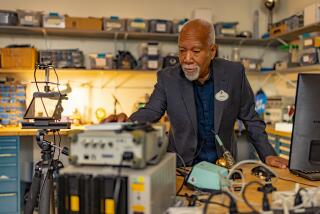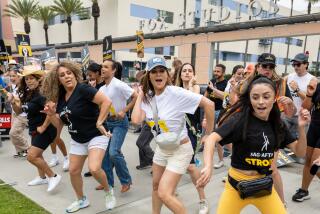Nuts, Bolts & Brains : Engineering: UC Irvine graduating seniors’ team projects demonstrate how technology and schematics can come together to solve real human problems.
- Share via
IRVINE — A lawn mower engine on a card table was not exactly the sort of senior project you might expect from the best and the brightest of UC Irvine’s mechanical engineering students.
But it was not the lawn mower engine that was relevant. What actually was on display was a new way to measure the energy efficiency of an engine.
“We do an inner thermodynamic analysis of the auto cycle,” graduating senior Cortland Strong said, standing next to the small, gloss-black engine his engineering team labored to connect to an array of digital monitoring devices.
“We compare the theoretical maximum with the actual cycle,” team member Greg Racciato clarified.
It was just an everyday conversation for the two mechanical engineering students, taking part Friday in the university’s annual exhibit of team projects by graduating mechanical and aerospace engineering seniors.
“When you get a bunch of mechanical engineering students at a party and we start talking, people tend to walk away and look at us like we’re space aliens,” Racciato said. “It’s just a subject that most people aren’t interested in. You learn not to talk about engineering around your non-engineering friends.”
But as arcane as some of the talk can be, exhibits such as the stair-climbing wheelchair demonstrate how nuts, bolts and schematics can come together to solve real human problems.
Despite the wheelchair access mandated by the 1990 Americans with Disabilities Act, somebody somewhere in a wheelchair will need to get up a flight of stairs, reasoned a group of six UCI engineering students who invested a year in the design of the self-powered stair climber.
Battery-powered wheelchairs that use infra-red sensors to climb stairs have been on the market but have proven impractical, engineering team member Dan Moody said.
“They cost about $20,000 and weigh about 1,000 pounds,” Moody said. “All the companies I know that made them are out of business because they’re just not practical.”
*
Moody and fellow team members hooked up with design engineer Michael Jacobs, who already was manufacturing a redesigned, three-wheel chair through his Costa Mesa company, Wheeling Free. Using Jacob’s chair, the students created a retractable mechanism that grips the stairs while the user manually pushes the wheels. Their prototype weighs about 100 pounds.
The trick was in designing a mountain-bike-type gear ratio that would not require excessive upper-body strength from the user.
“We also had to take into account that the better the gear ratio was for the user, the slower it would take to get up a flight of stairs,” student engineer Frank Kautzman said.
The stair-climbing wheelchair is symbolic of what mechanical engineers do, said John LaRue, an associate professor of mechanical and aerospace engineering at UCI.
“Mechanical engineers are involved with the transformation of energy in one form into a more useful form,” LaRue said. “That’s the thing that you’ll see everywhere around here.”
That’s what student David Chung was trying to do with his team’s Electron Magnetic Suspension device on display Friday. But team members conceded failure in trying to levitate a model train above its tracks using electromagnetic power. They were able to suspend a metal ball in midair, however.
“There’s no strings attached,” said Chung, pointing to the steel ball hovering inside an instrument-laden glass tube. With a “faster magnet” and an accelerometer, Chung said his team would have gotten their train off the ground.
The challenge for engineering student Tony Tyaan was to eliminate “fog juice,” a residue from smoke generators. Fog juice can contaminate research findings when smoke generators are used in wind-tunnel experiments, Tyaan said. His team created a device that traps the fog juice, producing a “cleaner” smoke.
The fog juice machine seems like a relatively simple device compared to the stereotactic fixation frame. Appearing to be part Tinker Toy and part Erector Set, the fixation frame was created to improve radiation therapy by targeting cancerous areas of the body with greater precision, shortening treatment time and reducing radiation exposure.
*
The device must be screwed into the skull and the hips to keep the patient absolutely motionless, but engineering student Keith Menor said it’s actually less painful than other types of procedures.
“It’s the first time anybody’s built a frame like this,” said Paul Medin, a neurosurgery research associate at UCLA who is working on the project with the UCI student engineers. “It just got finished this last week, so we have some testing to do.”
The projects on exhibit Friday illustrated a range of applications for the art of mechanical engineering, from a high-tech exhaust system to a design for a more crash-resistant formula racing car.
But for student Cortland Strong, tester of lawn mower engines, his passion is ball bearings.
“These are for things like missiles and satellites that require really high tolerance. Some of them can cost $100,000 plus,” Strong said with obvious enthusiasm for what he intends to make his life’s work.
“I like bearings a lot. Really.”
(BEGIN TEXT OF INFOBOX / INFOGRAPHIC)
Student Ingenuity A stair-climbing wheelchair was one of the inventions unveiled by UC Irvine engineering students. The chair is able to move up stairs when its wheels are rotated, which turns a chain, which spins a sprocket, driving a 3-inch-wide track. How it works: 1. Wheel works like bicycle pedal, rotating sprocket and spinning chain 2. Chain drives 3-inch-wide grooved belt on track 3. Track belt grabs riser, pulling chair to next step Source: Senior Design Report
More to Read
Inside the business of entertainment
The Wide Shot brings you news, analysis and insights on everything from streaming wars to production — and what it all means for the future.
You may occasionally receive promotional content from the Los Angeles Times.










